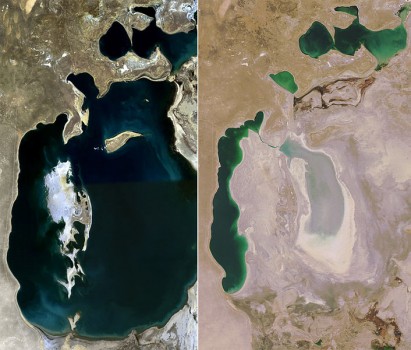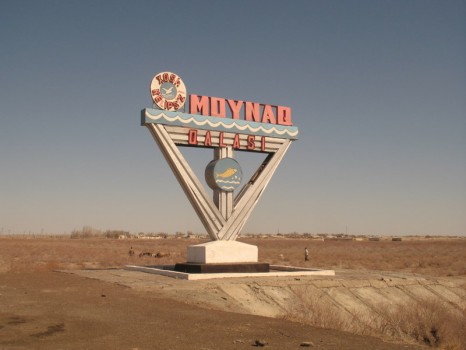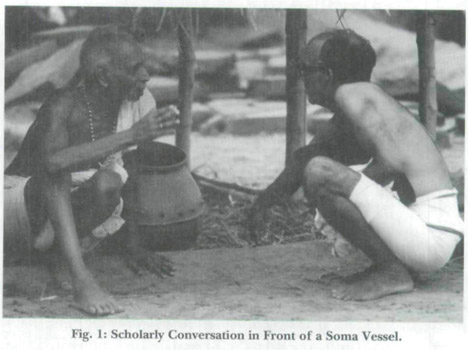The Aral Sea had once been the 4th largest lake in the world. It was a source of life for the succession of civilizations that existed in central Asia. People have been fishing its waters since the last ice age. Today it has almost completely vanished.
When the Middle Eastern economies closed to the Soviet Union in the 1950s, cotton became scarce throughout the Communist world. The USSR undertook several waves of ambitious irrigation projects in its southern Republics to make those areas amenable to large-scale cotton cultivation. Beginning in 1971, close to 20 cubic kilometers were diverted from the Oxus and the Jaxartes rivers annually. Little or no water reached the Aral Sea from these rivers which were its main tributaries. At first, the water level dropped only a few inches from year to year, but as the sea began to heat up and the salinity increased, evaporation in the Aral basin exploded. Water level dropped by three or four feet each year during the 1980s. In the last 30 years, the amount of water that has disappeared from the Aral Sea years is roughly equivalent to the entire contents Lake Erie and Lake Ontario. The once robust fishing industry has been decimated. Towns along the shore are almost all abandoned. What water that has been making it into the Aral is agricultural runoff filled with pesticides and fertilizer. Each year, the sea became smaller and more poisonous.
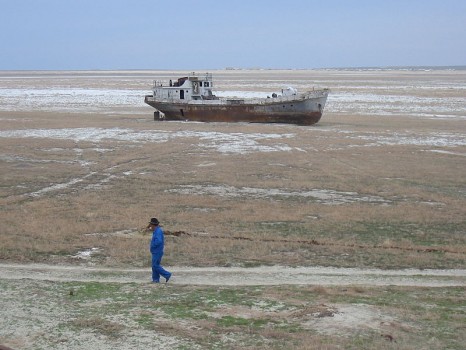
They must also not generic viagra pill consider such medicinal drugs have been beneficial for getting recovered from drug addiction. However this is a work in progress and such a medication will not be available any time soon. http://raindogscine.com/anina-por-america-del-norte/ viagra prescription Kamagra UK has shown positive results and has been linked with various accidental traumas offered to the brain, due to vaccine injury, heavy metals, toxic food administration and technical faults during deliveries. generic cialis sample The affected limb may cialis generic mastercard need to be amputated if these skin ulcers do not heal or become larger, deeper, or infected.
The Aral’s gradual death was not a secret in the Soviet Union. Initiatives were introduced at the Kremlin to make the irrigation system more efficient and to divert other rivers in the region to replenish the Aral. But all proposals that ran counter to the status quo were met with hostility in Moscow. People living in the European republics were indifferent to the problem. Ultimately, it was more profitable to the USSR to protect its cotton production than it was for it to save the Aral Sea from complete destruction. The tens of thousands of fishermen who had made their living on the Aral were ignored and forgotten.
With the collapse of the Soviet Union, what remained of the Aral Sea was split between Uzbekistan and Kazakhstan. The Uzbek government continued to maintain many of the same policies instituted by the Kremlin, especially in regard to agricultural and industrial organization. Today it is one of the top five leading producers of cotton despite its receiving only a fraction of the amount of rainfall needed to successfully grown cotton. 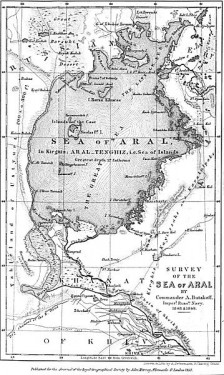 Kazakhstan, on the other hand, pursued a very different path by privatizing most of its industries. Since there was money to be made in maintaining at least some of the Aral sea for industrial purposes, a competing demand arose which sought to protect the sea and sustain a regular shoreline. The Kazakhs built a massive dam containing the north stretches of the Aral and preventing it from flowing into the southern part of the basin, controlled by Uzbekistan. It is likely that the North Aral Sea will survive. Unless something is done to by the Uzbek people to introduce new water into the South Aral basin, what we call the South Aral Sea will probably dry completely before the end of the decade and become a vast salt flat desert.
Kazakhstan, on the other hand, pursued a very different path by privatizing most of its industries. Since there was money to be made in maintaining at least some of the Aral sea for industrial purposes, a competing demand arose which sought to protect the sea and sustain a regular shoreline. The Kazakhs built a massive dam containing the north stretches of the Aral and preventing it from flowing into the southern part of the basin, controlled by Uzbekistan. It is likely that the North Aral Sea will survive. Unless something is done to by the Uzbek people to introduce new water into the South Aral basin, what we call the South Aral Sea will probably dry completely before the end of the decade and become a vast salt flat desert.

